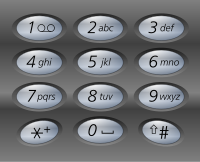Data Structure: Interview Experience Part 5(Microsoft)
Data Structure: Interview Experience Part 5(Microsoft)
Backtracking

-
Given a string containing digits from
2-9inclusive, return all possible letter combinations that the number could represent.
A mapping of digit to letters (just like on the telephone buttons) is given below. Note that 1 does not map to any letters.

Example:
Input: "23"
Output: ["ad", "ae", "af", "bd", "be", "bf", "cd", "ce", "cf"].
Note:
Although the above answer is in lexicographical order, your answer could be in any order you want.
Practise: https://leetcode.com/problems/letter-combinations-of-a-phone-number/
2. Wildcard Matching
Given an input string (s) and a pattern (p), implement wildcard pattern matching with support for
'?' and
'*'.
'?' Matches any single character.
'*' Matches any sequence of characters (including the empty sequence).
The matching should cover the entire input string (not partial).
Note:
-
scould be empty and contains only lowercase lettersa-z. -
pcould be empty and contains only lowercase lettersa-z, and characters like?or*.
Example 1:
Input:
s = "aa"
p = "a"
Output: false
Explanation: "a" does not match the entire string "aa".
Example 2:
Input:
s = "aa"
p = "*"
Output: true
Explanation: '*' matches any sequence.
Example 3:
Input:
s = "cb"
p = "?a"
Output: false
Explanation: '?' matches 'c', but the second letter is 'a', which does not match 'b'.
Example 4:
Input:
s = "adceb"
p = "*a*b"
Output: true
Explanation: The first '*' matches the empty sequence, while the second '*' matches the substring "dce".
Example 5:
Input:
s = "acdcb"
p = "a*c?b"
Output: false
Practise: https://leetcode.com/problems/wildcard-matching/
3. Given a 2D board and a list of words from the dictionary, find all words in the board.
Each word must be constructed from letters of sequentially adjacent cell, where “adjacent” cells are those horizontally or vertically neighboring. The same letter cell may not be used more than once in a word.
Example:
Input:
board = [
['o','a','a','n'],
['e','t','a','e'],
['i','h','k','r'],
['i','f','l','v']
]
words =["oath","pea","eat","rain"]
Output: ["eat","oath"]
Note:
-
All inputs are consist of lowercase letters
a-z. -
The values of
wordsare distinct.
Practise: https://leetcode.com/problems/word-search-ii/
4.
Given an input string (s) and a pattern (p), implement regular expression matching with support for '.' and '*'.
'.' Matches any single character.
'*' Matches zero or more of the preceding element.
The matching should cover the entire input string (not partial).
Note:
-
scould be empty and contains only lowercase lettersa-z. -
pcould be empty and contains only lowercase lettersa-z, and characters like.or*.
Example 1:
Input:
s = "aa"
p = "a"
Output: false
Explanation: "a" does not match the entire string "aa".
Example 2:
Input:
s = "aa"
p = "a*"
Output: true
Explanation: '*' means zero or more of the preceding element, 'a'. Therefore, by repeating 'a' once, it becomes "aa".
Example 3:
Input:
s = "ab"
p = ".*"
Output: true
Explanation: ".*" means "zero or more (*) of any character (.)".
Example 4:
Input:
s = "aab"
p = "c*a*b"
Output: true
Explanation: c can be repeated 0 times, a can be repeated 1 time. Therefore, it matches "aab".
Example 5:
Input:
s = "mississippi"
p = "mis*is*p*."
Output: false
Practise: https://leetcode.com/problems/regular-expression-matching/
Hope this article is useful for people looking to learn and practice Data structure & Algorithm in swift, Please ❤️ to recommend this post to others 😊. Let me know your feedback. :)